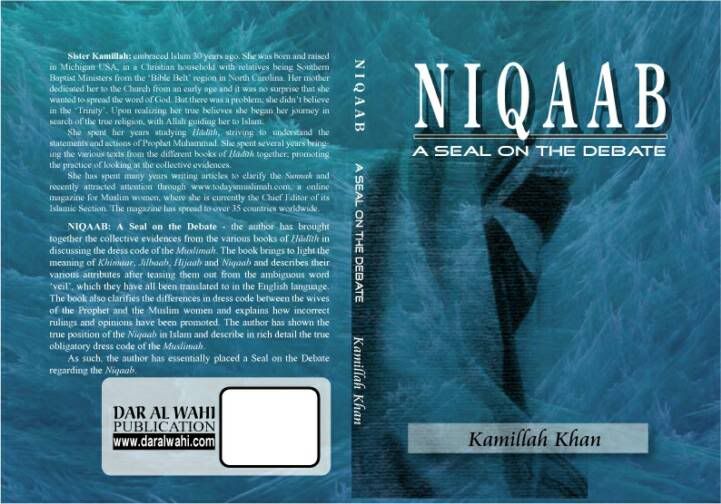The Book:
Niqaab: A Seal On The
Debate has been published on the web at www.todaysmuslimah.com since
2006 with full copyright. AlHumdulillah It is now available in book
form. More deatils to follow Inshaa Allah. It can be purchased directly
from the publisher at daralwahi@yahoo.com. And in the USA from A.S.
Noordeen. Also it can be purchased online, google " Niqaab A Seal On The
Debate" to obtain names of islamic bookstores.
Publishers Copyright
All Rights reserved. No part of
this publication may be produced, stored in a retreival system, or
transmitted, in any form or by any means, electronic, mechanical,
photocopying, recording or otherwise without the prior permission of the
Publisher. This book can not be translated into another language
without the permission of the Publisher. The Dolls by Umm Hend are part
of this publication and protected by copyright law.
About The Author

Sister Kamillah embraced Islam 30
years ago. She was born and raised in Michigan USA, in a Christian
household with relatives being Southern Baptist Ministers from the
'Bible Belt' in North Carolina. Her mother dedicated her to the Church
from an early age and it was no surprise that she wanted to spread the
Word of God. But there was a problem; she didn't believe in the Trinity.
Upon realizing her true believes she began her journey in search of the
true religion, with Allah guiding her to Islam.
She spent her years studying
Hadeeth striving to understand the statements and actions of Prophet
Muhammad (saws). She spent several years bringing the various texts from
the different books of Hadeeth together; promoting the practice of
looking at the collective evidences.
She has spent many years writing
articles to clarify the Sunnah and recently attracted attention through
www.todaysmuslimah.com, an online magazine for Muslim women, where she
is currently the Chief Editor of its Islamic Section. The magazine has
spread to over 35 countries worldwide.
About The Book

The author has brought together
the collective evidences from the various books of Hadeeth in discussing
the dress code of the Muslimah. The book brings to light the meaning of
Khimaar, Jilbaab, Hijaab and Niqaab and describes their various
attributes after teasing them out from the ambiguous word 'veil' which
have all been translated into the English language. The Book also
clarifies the differences in dress code between the Wives of the Prophet
and the Muslim women and explains how incorrect rulings and opinions
have been promoted. The author has shown the true position of the Niqaab
in Islam and described in rich detail the true obligatory dress code of
the Muslimah. As such the author has essentially placed a Seal on the
Debate regarding the Niqaab.
Extract From The Book

The truth regarding the Niqaab
issue will never be found if we continue to simply quote the opinions of
the scholars for they have differed and the truth is one, with the
truth found in the narrations. Instead we need to address this issue
through the proofs found in the collective narrations and not simply cut
and paste one text here and one text there. In fact we have to take
from where the scholars took until we review their evidences and compare
them with the evidences found in the collective texts in the various
books of Ahadeeth. Thus did Allah instruct us to refer back to Him and
His Messenger in all matters of dispute, and the scholars of Islam
upheld this noble command, calling mankind back to the Speech of Allah
and the guidance of Muhammad This is what the scholars advocated.
They never advocated blind following of their statements, nor were they
always correct in each and every ruling, nor were their words completely
free from untruths. Consensus amongst the scholars is one thing, and
their differing another thing, with their differing requiring a more
vigorous review of the narrations.
Yet Instead of referring back to
the Qur’aan and Sunna on the issue of the Muslimah’s dress code, our
time has been flooded with the cutting and pasting of opinions without
recourse to the collective narrations. If we review the various
articles, writings and postings on the issue of Hijaab and Niqaab we
will find that many English texts have been badly translated and the
evidences themselves poorly presented, with the end point being
promoting a view instead of propagating the Haq.
Let us leave the opinions for a
moment and return to the evidences found within the Qur’aan and Sunna
for this is the knowledge that we seek. Before looking at the evidences
we begin by addressing some of the serious problems found in the English
translations of the texts pertaining to the dress code of the Muslimah.
These problems most surely require our consideration with a view to
seek correction and restoration of what exactly was said.
(A) Identifying the Ambiguous
English Translations of Verses in The Qur’aan
And tell the believing women to
lower their gaze and protect their private parts, and not to show off
their adornment except only that which is apparent, and to draw their
veils (Khumur) all over their Juyub. (Qur’aan 24:31/Ref1)
O Prophet! Tell your wives and
your daughters and the women of the believers to draw their cloaks
(veils) (Jalaabeeb) all over their bodies. That will be better, that
they should be known so as not to be annoyed. And Allah is Ever Oft
Forgiving, Most Merciful. (Qur’aan 33:59/Ref2)
When we look at the translations
of the words Khumur and Jalaabeeb we find that they have been translated
as veils and cloaks respectively in Muhsin Khan’s translation of the
Qur’aan. However, we also find that the word ‘veils’ appears in brackets
when translating the word Jalaabeeb, which causes confusion to some
readers who fail to distinguish the veiling of the Khumur from the
veiling of the Jalaabeeb.
And when you ask (his wives) for anything you want, ask
them from behind a screen (Hijaab). That is purer for your hearts and
for their hearts. (Qur’aan 33:53/Ref3)
O Prophet! Tell your wives and
your daughters and the women of the believers to draw their cloaks
(veils) (Jalaabeeb) all over their bodies (ie. screen themselves
completely except the eye or one eye to see the way). (Qur’aan
33:59/Ref4)
When we look at the verse of the Hijaab we find the word
Hijaab has been translated as screen. However Muhsin Khan also describes
the Jilbaab as a screen, which he mentions in brackets. So how is the
screening of the Hijaab distinct from the screening of the Jilbaab?
It would have been better to
highlight the words Khumur, Jalaabeeb and Hijaab, and retain them in the
English translations of the texts. Thereafter these words could have
been explained in footnotes or explanatory notes. By neglecting this
methodology, the above translated texts are clearly a means of
confusion.
The Arabic Ahadeeth, explain and clarify the meaning the
Arabic Qur’aan, so we would have hoped that the English translations of
the Ahadeeth, would have clarified the English translation of the
Qur’aan, along with these words Khumur, Jalaabeeb and Hijaab. However
when reviewing the translated Ahadeeth concerning the female Islamic
dress code, we find the confusion only increases, with many texts being
clearly ambiguous and misleading.
(B) Identifying the Ambiguous
English Translations of the Ahadeeth
Aaeyshah said that the lady
(came), wearing a green veil (Khimaar). (saheeh of bukhaari/Ref5)
Hafsah bint Sireen said, “We used
to forbid our girls to go out on the day of Eid. A woman came and
stayed at the palace of Bani Khalaf and I went to her. She said, ‘The
husband of my sister took part in twelve battles along with the Prophet
and my sister was with her husband in six of them. My sister said
they used to nurse the sick and treat the wounded. Once she was asked,
‘O Messenger of Allah! If a woman has no veil (Jilbaab) is there any
harm if she doesn’t come out?’ The Prophet said, ‘Her companion
should let her share her veil (Jilbaab) with her.’ (saheeh of
bukhaari/Ref6)
Narrated Umar, I said, ‘O Messenger of Allah good and bad
persons enter upon you, so I suggest that you order the mothers of the
believers to observe veil (Hijaab)’ (saheeh of bukhaari/Ref7)
In the above narrations, the
words Khimaar, Jilbaab, and Hijaab have all been translated as veil.
Jilbaab is singular for Jalaabeeb and Khimaar is singular for Khumur. So
when the English reader studies these texts they will not be able to
distinguish between the covering of the Khimaar, Jilbaab, and Hijaab,
because all these words have been translated to mean veil.
Abdullah bin Umar narrated that
he heard the Messenger of Allah say, 'The Women in Ihraam should
neither put on gloves nor the (veil) Niqaab.' (sunan of abu dawood/Ref8)
Other texts describe the Niqaab
such as the above narration which describes how a Muhrimah cannot wear
the Niqaab. But again, the English translation of the word Niqaab is
veil. So now we have four words, all describing the veil.
Aaeyshah narrated, ‘The believing
women used to attend Fajr prayer with the Messenger of Allah, covered
with their veiling sheets (Muroot).’ (saheeh of bukhaari /Ref9)
Other texts include the word
Muroot which is translated as veils in the form of veiling sheets. So
now we have five words, all translated as veil.
Ataa’ said, ‘I and Ubaid bin
Umair used to visit Aaeyshah while she was residing at Jauf Thabeer.’
Ibn Juraij asked, ‘What was her Hijaab?’ Ataa’ replied, ‘She was wearing
an old Turkish veil (Qubbah Turkeyyah). And there was nothing between
us and her except that. (saheeh of bukhaari/Ref10)
In the above hadeeth the Hijaab
of Aaeyshah has been described as a Qubbah Turkeyyah, which has been
translated as an old Turkish veil. So now we have a sixth word, Qubbah,
which has also been translated as veil.
So when we look at the numerous
English texts pertaining to the dress of the Muslimah, what do we have
except the fact that the word veil has prevailed, leaving us with the
real question-what is the veil?
Taken from the Book 'Niqaab A Seal
On The Debate' by Kamillah Khan 








 Please check our
Please check our 







